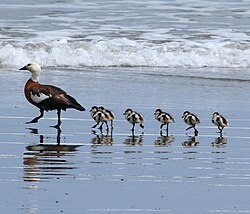



Imprinting is a term, used in ethology to describe a special type of automatic learning, that occurs during an animal's development. [1]
Imprinting is when an early sight, sound, or smell during a short period leaves a long-lasting mark called an imprint on the young animal's nervous system. It often happens after one or a few experiences and is hard to reverse. [1] [2] [3]
The word imprinting has different meaning in different fields. In genetics it means Genomic imprinting, [4] and in psychology the word is used more broadly to describe learned behaviours (see Imprinting (psychology)). [5]
Imprinting usually occurs early in life, during a sensitive period. That is why textbooks sometimes call it phase-sensitive learning. [6] [1] It is learning that happens at a particular age or life stage. The animal fixes on a particular signal (for example, sound, sight or smell) that creates an imprint of the object it later prefers. [3]
The process involves both instinct and learning. Imprinting makes certain stimuli especially easy to learn about for young animals. [1] [6]
The best-known form is filial imprinting, in which newly hatched or newborn animals imprint on a parent. Its function is to keep the young close to their parent(s) during the early learning period. It is most obvious in birds, such as ducks and geese, whose young often follow a parent in a line on land or water. [3]
Imprinting was first reported in domestic chickens by the 19th-century biologist Douglas Spalding. [7] [8] It was later developed by the early ethologist Oskar Heinroth, and studied extensively and popularised by his student Konrad Lorenz, and by Niko Tinbergen. [9] [10] [11]
Lorenz showed how just-hatched geese would imprint on the first suitable moving stimulus they saw, for example, a person's boots. The geese would then follow it. [10] Later laboratory work measured the timing of imprints. In ducklings the imprinting process can happen during 12–17 hours after hatching, but not after that. [12] [13]
In child development, some writers use the word imprinting for early experiences that help babies know their caregivers. Newborn humans prefer their mother's voice, and this recognition might begin before birth. [14] [15]
Filial imprinting of birds was used to make the movie Winged Migration . Hand-reared birds imprinted on handlers and learned to fly alongside ultralight aircraft, allowing close-up filming. [16] [17]